There are a wide variety of technologies that are used to print stuff. The main industrial printing processes are:
- Offset lithography
- Flexography
- Digital printing: inkjet & xerography
- Gravure
- Screen printing
Additional printing techniques were developed for very specific applications. These include flock printing, letterpress, intaglio, pad printing, and thermography.
Why a certain job is better printed using one of these processes mentioned can be read on this page about choosing a printing process.
Offset
In offset lithography a printing plate, which is most often made from aluminum, contains an image of the content that needs to be printed. When the plate is inked, only this image part holds ink. That inked image is subsequently transferred (or offset) from the plate to a rubber blanket and then to the printing surface. The process can be used to print on paper, cardboard, plastic or other materials, but these have to have a flat surface.
Below is a picture of a 4 color sheetfed printing press. At the far end is the intake where individual sheets of paper are automatically fed into the press. The 4 towers or printing units each print one color, typically black get printed first, followed by cyan, magenta and yellow. The stack of printed sheets is visible on the front of the machine, underneath the press console & monitor which the press operator uses to control the press.
For higher volume work offset presses use rolls of paper. The picture below shows such a much larger web press. It is so fast that the printed paper needs to be force dried. The black unit at the end of the press is an oven.
Offset is nowadays the most widely used printing technique for an extensive range of products such as books, newspapers, stationery, corrugated board, posters, etc.
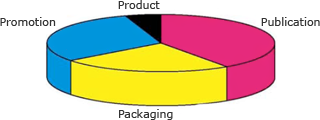 There is a trend that printing promotional material is gradually migrating to digital printing while some packaging printing is moving to flexo.
There is a trend that printing promotional material is gradually migrating to digital printing while some packaging printing is moving to flexo.
You can find more information on the page dedicated to offset printing.
Flexo
In flexography the content that needs to be printed is on a relief of a printing plate, which is made from rubber. This plate is inked and that inked image is subsequently transferred to the printing surface. The process can be used to print on paper as well as plastics, metals, cellophane and other materials. Flexo is mainly used for packaging and labels and to a lesser extent also for newspapers.
Digital printing
Digital printing can be done in various ways. Two technologies dominate the industry:
- Inkjet – In an inkjet printer the image that needs to be printed is created by small droplets of ink that are propelled from the nozzles of one or more print heads. Inkjet devices can print on a wide range of substrates such as paper, plastic, canvas or even doors and floor tiles. Inkjet printing is used a lot for posters and signage. It is also economical for short run publications such as photo books or small runs of books. In-line inkjet printers are sometimes combined with other types of presses to print variable data, such as the mailing addresses on direct mail pieces. The press shown below is the HP PageWide C500, meant for printing on corrugated board.
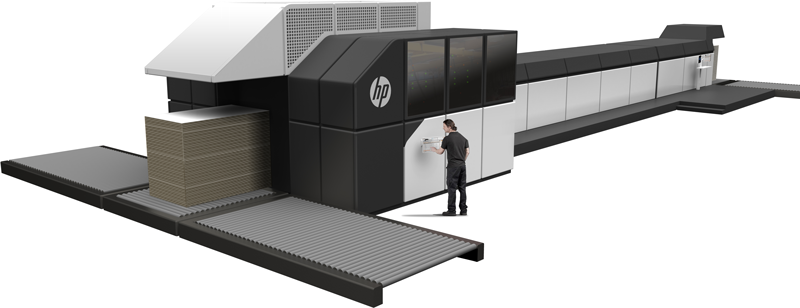
- Xerography – In xerographic printers, such as laser printers, the image that needs to be printed is formed by selectively applying a charge to a metal cylinder called a drum. The electrical charge is used to attract toner particles. These particles are transferred to the media that is being printed on. To make sure the toner is fixed properly, the substrate passes through a fuser that melts the toner into the medium. Laser printers are not only used in offices but also for small run printing of books, brochures and other types of document. These printers are also used for transactional printing (bills, bank documents, etc) and direct mail.
In 2009 both techniques jointly accounted for around 15% of the total volume of print.
 Digital printing is increasingly utilized for print jobs that were previously printing using offset, flexo or screen printing.
Digital printing is increasingly utilized for print jobs that were previously printing using offset, flexo or screen printing.- In short run small format (A3 size) printing, digital is taking over from offset for both color and B&W printing. Quick printers and copy shops print digitally on presses from vendors like Xerox, HP, Canon, and Konica Minolta.
- Labels are also increasingly being printed digitally.
- Billboard and point-of-sale or point-of-purchase jobs are being done by wide-format inkjet devices.
- There is a wide range of small format printers used to print on phone cases, mugs and other products.
- In book printing publishing companies start to rely more on print-on-demand. The Espresso Book Machine pictured below is well suited for that job.
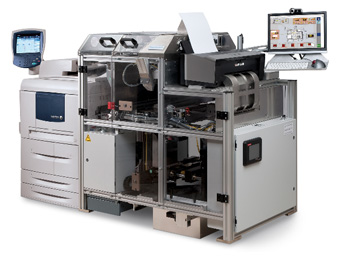
There are a number of other digital printing processes that are geared towards specific niche markets:
- Dye-sublimation is a printing process in which heat is used to transfer a dye onto the substrate. Dye-sub printers are mainly used for printing on textiles, for proofing and for producing photographic prints. Some printers can print on a variety of materials such as paper, plastic, and fabric.
- In the direct thermal printing process heat is used to change the color of a special coating that has been applied to paper. This process is used in cash registers but also to add markings, such as serial numbers, to products. For this a transparent ink is used that changes color when a laser applies heat to it.
- In the thermal ink transfer printing process heat is used to melt print off a ribbon and onto the substrate. It is used in some proofing devices but seems to be gradually disappearing off the market.
Gravure
Also known as rotogravure, this is a technique in which an image is engraved into a printing cylinder. That cylinder is inked and this ink subsequently transfers to the paper. Gravure is used for high volume work such as newspapers, magazines, and packaging.
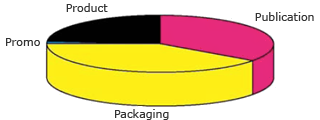 Gravure is gradually losing market share to offset for publication printing and to flexo for packaging applications.
Gravure is gradually losing market share to offset for publication printing and to flexo for packaging applications.Screen printing
As its name implies, this printing technique relies on a screen, which is a woven piece of fabric. Certain areas of this mesh are coated with a non-permeable material. In the remaining open spaces ink can be pushed through the mesh onto a substrate. The advantage of screen printing is that the surface of the recipient does not have to be flat and that the ink can adhere to a wide range of materials, such as paper, textiles, glass, ceramics, wood, and metal.
The image below shows a screen printing press that is used to print t-shirts.
Additional printing processes
- Letterpress – Once a dominant printing technique, letterpress is now used for business cards, wedding invitations,…
- Flocking – used to add a (colored) velvet-like texture to paper, textiles, etc.
- Pad printing – used to print on 3-dimensional surfaces.
- Intaglio – nowadays mainly used for used stamps and paper currency.
- Thermography – This is more of a finishing process than an actual printing process. It produces raised lettering on the printed side of the paper and is used for wedding invitations, letterheads, business cards,…
Source: https://www.prepressure.com/printing/processes
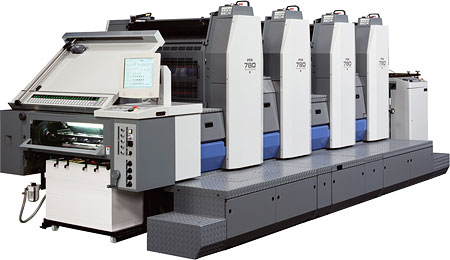


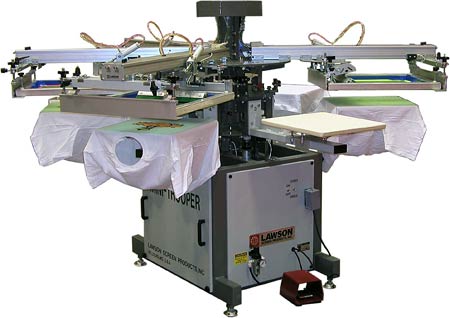
No comments:
Post a Comment
Hi All, Please leave a comment. ^_^